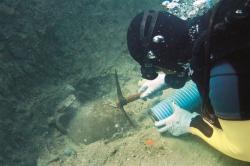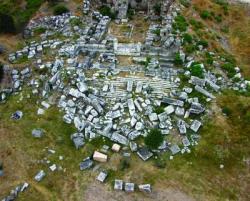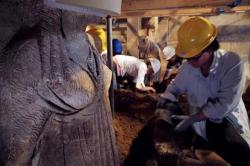INSTITUT SUPERIEUR D'ANTHROPOLOGIE
INSTITUTE OF ANTHROPOLOGY
ONLINE COURSES / COURS A DISTANCE
FALL TERM : OCTOBER 2014
REGISTER NOW
TURQUIE –  Urla - Underwater excavations led by Ankara University’s Research Center for Maritime Archaeology (ANKÜSAM) have uncovered sunken ships ranging from the second century B.C. to the Ottoman period in İzmir’s Urla district. A recent excavation uncovered a ship estimated to date back 4,000 years, which experts say would make it the oldest sunken ship to have been discovered in the Mediterranean. Urla Port is one of Turkey’s rare underwater excavation sites. Professor Hayat Erkanal, the head of Limantepe excavations for the underwater ancient city of Klozemenai and director of ANKÜSAM, said the port dates back to the seventh century B.C. Klozemenai, he explained, was a coastal town, making it the home of many sunken ships from different eras. An earthquake in the eighth century left the city underwater. There are two other sunken boats that compete for the title of the world’s oldest, Erkanal said. The Uluburun shipwreck, found off the coast of Kaş, is around 3,500 years old, while the sunken ship of Hatshepsut, the fifth pharaoh of Ancient Egypt’s 18th dynasty, is dated to be around 150 years older.
Urla - Underwater excavations led by Ankara University’s Research Center for Maritime Archaeology (ANKÜSAM) have uncovered sunken ships ranging from the second century B.C. to the Ottoman period in İzmir’s Urla district. A recent excavation uncovered a ship estimated to date back 4,000 years, which experts say would make it the oldest sunken ship to have been discovered in the Mediterranean. Urla Port is one of Turkey’s rare underwater excavation sites. Professor Hayat Erkanal, the head of Limantepe excavations for the underwater ancient city of Klozemenai and director of ANKÜSAM, said the port dates back to the seventh century B.C. Klozemenai, he explained, was a coastal town, making it the home of many sunken ships from different eras. An earthquake in the eighth century left the city underwater. There are two other sunken boats that compete for the title of the world’s oldest, Erkanal said. The Uluburun shipwreck, found off the coast of Kaş, is around 3,500 years old, while the sunken ship of Hatshepsut, the fifth pharaoh of Ancient Egypt’s 18th dynasty, is dated to be around 150 years older.
http://www.hurriyetdailynews.com/millennia-old-sunken-ship-could-be-worlds-oldest-researchers-suggest.aspx?pageID=238&nID=71285&NewsCatID=375
TURQUIE – 
 Ephese - The temple of Serapis, which was discovered in İzmir’s ancient city of Ephesus and is estimated to have collapsed in an earthquake, will be restored to its original condition. Experts have said the temple, built in the 2nd century A.D. as a devotion to the Egyptian god Serapis, is the best preserved and largest temple in Anatolia. Constructed on an area of 7,700 square meters, the area of the structure is over 1,000 square meters. Built 1,800 years ago, the temple’s remains have been left scattered about due to an earthquake, still it’s reported that nearly 100 percent of the temple’s pieces are still intact. The restoration of the temple has been undertaken by the Ephesus Foundation and it is widely expected that the temple will become the second face of Ephesus, following the Celsius Library, after its restoration
Ephese - The temple of Serapis, which was discovered in İzmir’s ancient city of Ephesus and is estimated to have collapsed in an earthquake, will be restored to its original condition. Experts have said the temple, built in the 2nd century A.D. as a devotion to the Egyptian god Serapis, is the best preserved and largest temple in Anatolia. Constructed on an area of 7,700 square meters, the area of the structure is over 1,000 square meters. Built 1,800 years ago, the temple’s remains have been left scattered about due to an earthquake, still it’s reported that nearly 100 percent of the temple’s pieces are still intact. The restoration of the temple has been undertaken by the Ephesus Foundation and it is widely expected that the temple will become the second face of Ephesus, following the Celsius Library, after its restoration
http://www.hurriyetdailynews.com/temple-of-serapis-in-ephesus-undergoes-restoration-.aspx?PageID=238&NID=71586&NewsCatID=375
TURQUIE –  Yumuktepe - Ongoing archaeological excavations in one of the world’s oldest settlements, the Yumuktepe tumulus in the southern province of Mersin, have unearthed the remains of a palace. The palace dates to as far back as 4,500 B.C., and the quality of the pavement outside the palace was a big surprise for archaeologists. Traces of settlements at Yumuktepe date back to 7,000 B.C. and settlements continued there until the 13th century. The excavation works in Yumuktepe are currently headed by Professor Isabella Caneva, from the Archeology Department in Italy’s Lecce University. Caneva said this year’s works started one month ago and focused on the layers of the chalcolithic era in 5,000 B.C, yielding good results so far. The remains of the palace were discovered during works in previous years, she added. “This year’s work completely revealed the outline of the palace. We call it palace because it is a big building. It is from 4,500 B.C., the late chalcolithic era. At these times, normal houses were very small but there is a very big hall here. Each room was also floored with adobe. There were nearly 200 cups and ceramics, which means the meal was cooked for many people here. People who lived here were not a normal family but a large or elite family,” Caneva said. Yumuktepe, also known as Soğuksutepe, was founded 9,000 years ago by Neolithic farmers, whose ruined homes now form the core of the archeological ruins. The first excavation was from 1936 to 1938 by J. Garstang. It was the only Neolithic site known of in the Near East until the mid-20th century. The well-watered plain of Mersin rises towards inner Anatolia on one side, and opens towards Syria and the Levant on the other. The charred remains of pistachio, oak and pine trees from the earlier levels at Yumuktepe shows that the area was much more densely forested than in modern times .
Yumuktepe - Ongoing archaeological excavations in one of the world’s oldest settlements, the Yumuktepe tumulus in the southern province of Mersin, have unearthed the remains of a palace. The palace dates to as far back as 4,500 B.C., and the quality of the pavement outside the palace was a big surprise for archaeologists. Traces of settlements at Yumuktepe date back to 7,000 B.C. and settlements continued there until the 13th century. The excavation works in Yumuktepe are currently headed by Professor Isabella Caneva, from the Archeology Department in Italy’s Lecce University. Caneva said this year’s works started one month ago and focused on the layers of the chalcolithic era in 5,000 B.C, yielding good results so far. The remains of the palace were discovered during works in previous years, she added. “This year’s work completely revealed the outline of the palace. We call it palace because it is a big building. It is from 4,500 B.C., the late chalcolithic era. At these times, normal houses were very small but there is a very big hall here. Each room was also floored with adobe. There were nearly 200 cups and ceramics, which means the meal was cooked for many people here. People who lived here were not a normal family but a large or elite family,” Caneva said. Yumuktepe, also known as Soğuksutepe, was founded 9,000 years ago by Neolithic farmers, whose ruined homes now form the core of the archeological ruins. The first excavation was from 1936 to 1938 by J. Garstang. It was the only Neolithic site known of in the Near East until the mid-20th century. The well-watered plain of Mersin rises towards inner Anatolia on one side, and opens towards Syria and the Levant on the other. The charred remains of pistachio, oak and pine trees from the earlier levels at Yumuktepe shows that the area was much more densely forested than in modern times .
http://www.hurriyetdailynews.com/palace-unearthed-in-mersins-ancient-settlement-yumuktepe-.aspx?pageID=238&nID=71594&NewsCatID=375
IRLANDE –  Coney Island - Archaeologists have discovered signs of human habitation, possibly dating back 4,000 years, on Sligo’s Coney Island. A box-like structure built from large stone slabs found on the island may have been used for bathing or cooking during the Bronze Age, experts believe. The structure is thought to be part of a fulacht fiadh, a prehistoric trough or pit that was dug into the ground and filled with water. Stones, heated separated on an outdoor hearth, would be added to bring the water to boil. Measuring about a metre long and 80cm wide, the structure was recently identified as an archaeological site Radiocarbon dating will determine the exact age of the discovery.
Coney Island - Archaeologists have discovered signs of human habitation, possibly dating back 4,000 years, on Sligo’s Coney Island. A box-like structure built from large stone slabs found on the island may have been used for bathing or cooking during the Bronze Age, experts believe. The structure is thought to be part of a fulacht fiadh, a prehistoric trough or pit that was dug into the ground and filled with water. Stones, heated separated on an outdoor hearth, would be added to bring the water to boil. Measuring about a metre long and 80cm wide, the structure was recently identified as an archaeological site Radiocarbon dating will determine the exact age of the discovery.
https://www.irishtimes.com/news/environment/prehistoric-pit-discovered-on-coney-island-beach-1.1924538
GRECE –  Amphipolis - Archaeologists working at the site of a vast ancient tomb in Amphipolis, northern Greece, on Thursday uncovered the bodies of two sculpted female figures, or caryatids, whose heads were unearthed over the weekend. The life-sized marble statues flank the entrance to one of the tomb’s underground chambers which archaeologists are carefully exploring. According to a Culture Ministry statement issued on Thursday, the statues are of “exceptional artistic quality.” The Amphipolis excavation has fueled intense media attention as the site dates to the era of Alexander the Great’s death and some archaeologists have suggested relatives of the warrior king might be buried there.
Amphipolis - Archaeologists working at the site of a vast ancient tomb in Amphipolis, northern Greece, on Thursday uncovered the bodies of two sculpted female figures, or caryatids, whose heads were unearthed over the weekend. The life-sized marble statues flank the entrance to one of the tomb’s underground chambers which archaeologists are carefully exploring. According to a Culture Ministry statement issued on Thursday, the statues are of “exceptional artistic quality.” The Amphipolis excavation has fueled intense media attention as the site dates to the era of Alexander the Great’s death and some archaeologists have suggested relatives of the warrior king might be buried there.
http://www.ekathimerini.com/4dcgi/_w_articles_wsite1_1_11/09/2014_542839
Archaeologists working at the site of Amphipolis, northern Greece, on Friday gained access to the third chamber of the massive tomb.The site workers entered the chamber after removing a large volume of earth behind a wall bearing the two sculpted female figures, or caryatids, that were uncovered over the weekend.
http://www.ekathimerini.com/4dcgi/_w_articles_wsite1_1_12/09/2014_542860?